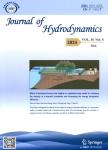Hydrodynamic mechanisms of aggressive collapse events in leading edge cavitation
在前缘成穴的好攻击的倒塌事件的水动力学机制作者机构:Department of Mechanics and Maritime SciencesChalmers University of TechnologyGothenburgSweden Laboratory for Hydraulic MachinesEPFLLausanneSwitzerland
出 版 物:《Journal of Hydrodynamics》 (水动力学研究与进展B辑(英文版))
年 卷 期:2020年第32卷第1期
页 面:6-19页
核心收录:
学科分类:080103[工学-流体力学] 08[工学] 080104[工学-工程力学] 081502[工学-水力学及河流动力学] 0815[工学-水利工程] 0801[工学-力学(可授工学、理学学位)]
基 金:This work is funded through the EU H2020 project CaFE a Marie Sklodowska-Curie Action Innovative Training Network project(Grant No.642536).The computations were performed on resources at Chalmers Centre for Computational Sciences and Engineering(CSE)provided by the Swedish National Infrastructure for Computing(SNIC)
主 题:Hydrodynamic mechanisms aggressive collapse events high-speed visualization(HSV) paint test compressible simulation of cavitating flows
摘 要:Transient cavities generated from unsteady leading-edge cavitation may undergo aggressive collapses which are responsible for cavitation *** this paper,we studied the hydrodynamic mechanisms of these events in the leading edge cavitation fonned over a modified NACA0009 hydrofoil using experimental and numerical *** the experimental investigation,high-speed visualization(HSV)and paint test are employed to study the behavior of the cavitating flow at σ=1.25,α=5°,U∞=20 m/*** the numerical part,the same cavitating flow is simulated using an inviscid density-based compressible solver with a barotropic cavitation *** numerical results are first compared with the experimental HSV to show that the simulation is able to reproduce the main features of the cavitating ***,as the compressible solver is capable of capturing the shock wave upon the collapse of cavities,the location of collapse events with high erosion potential are *** location of these collapse events are compared with the paint test results with a qualitatively good *** is clearly observed,in both the experiments and the numerical simulation,that there exists four distinct regions along the hydrofoil with higher risks of erosion:(1)A very narrow strip at the leading edge,(2)an area of accumulated collapses at around 60 percent of the sheet cavity maximum length,(3)an area around the closure line of the sheet cavity with the highest erosion damage,and(4)a wide area close to the trailing edge with dispersed collapse events.A combined analysis of the experimental and numerical results reveals that the small-scale structures generated by secondary shedding are more aggressive than the large-scale cloud cavities(primary shedding).It is also observed that the high risk of cavitation erosion in regions 2 and 3 is mainly due to the collapses of the small cavity structures that are formed around the sheet cavity closure line or the rolling cloud cavity.




